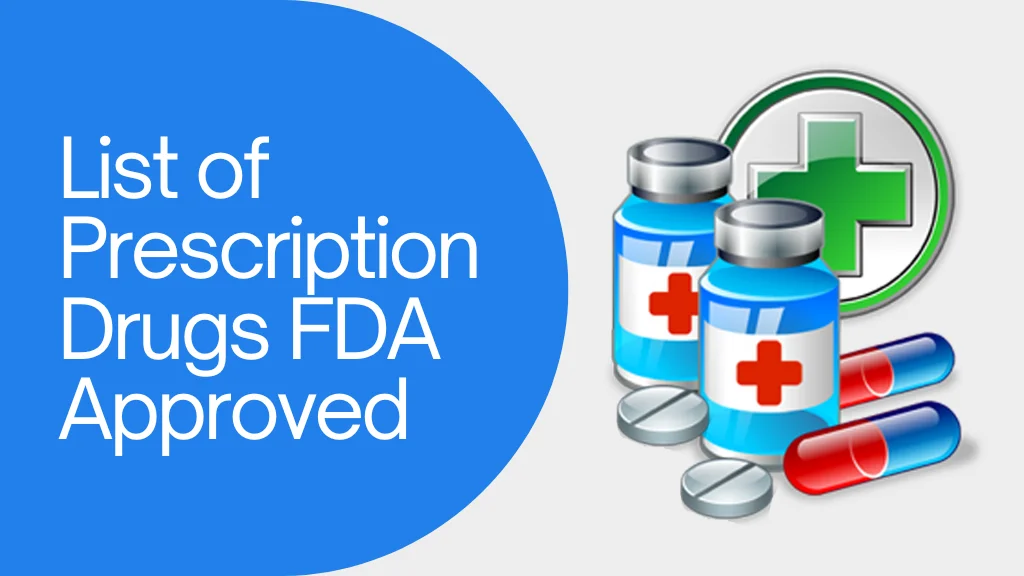Medicine has always been at the center of human progress. From the early discovery of penicillin to advanced biologic therapies that treat rare diseases, prescription drugs have extended life expectancy and improved quality of life for millions worldwide. But behind every trusted prescription lies a story of rigorous evaluation, years of research, and careful regulation. In the United States, the U.S. Food and Drug Administration (FDA) is the authority responsible for this oversight. The official list of prescription drugs FDA approved serves as a gold standard, confirming that a medicine is not only effective but also safe for public use.
This list is vital for both patients and healthcare providers. Unlike over-the-counter remedies, prescription drugs are stronger, riskier, and often used for complex conditions that require a doctor’s supervision. Without FDA oversight, the risk of counterfeit, contaminated, or ineffective drugs would be alarmingly high. Knowing that a drug is FDA-approved allows patients to take their treatments with confidence, and doctors to prescribe them with responsibility.
The FDA Approval Process in Greater Depth
FDA approval is not a quick or casual decision. It is the result of years of scientific investigation, clinical trials, and regulatory checks. The process can take a decade or longer and cost billions of dollars in research and development. Yet it remains necessary to protect public health.
Investigational New Drug (IND) Application
Before clinical testing in humans begins, drug developers must submit an IND application to the FDA. This document provides preclinical data showing that the drug is reasonably safe for initial trials. It includes details on how the drug will be manufactured, how trials will be conducted, and how patients will be protected during the study. Without IND clearance, no human trial can legally begin.
Clinical Trial Phases Explained in Detail
Once approved for testing in humans, a drug moves through several trial phases:
Phase 1 Trials
These trials typically involve fewer than 100 healthy volunteers. The primary purpose is to assess safety, determine safe dosage ranges, and identify side effects.
Phase 2 Trials
These trials expand to a few hundred patients who actually have the disease or condition the drug is designed to treat. Researchers focus on whether the drug works and continue monitoring its safety.
Phase 3 Trials
Involving thousands of patients across diverse populations, Phase 3 trials provide large-scale data on effectiveness, side effects, and long-term risks. This stage often includes comparison with existing treatments.
Phase 4 and Post-Market Monitoring
After FDA approval, the drug enters real-world use. Phase 4 studies collect additional data about long-term effectiveness and rare side effects that may not have appeared during earlier trials.
New Drug Application (NDA) and Biologics License Application (BLA)
When clinical trials are complete, drug manufacturers submit either an NDA (for chemically synthesized drugs) or a BLA (for biologics derived from living organisms). These applications can be tens of thousands of pages long, containing detailed trial results, manufacturing protocols, and labeling information.
The FDA reviews these applications with teams of scientists, statisticians, and medical experts. Approval is granted only if evidence proves that the drug is effective, its risks are manageable, and it can be manufactured consistently at high quality.
Why FDA Approval Matters for Patients and Society
FDA approval is more than a formality; it is a promise of safety, reliability, and trust. Without it, patients would be left vulnerable to ineffective or harmful medications.
Guarantee of Effectiveness and Safety
Drugs included in the FDA-approved list have undergone testing in thousands of patients across different age groups, genders, and health conditions. This ensures that the drug is effective for its intended use and that its side effects are manageable when taken as directed.
Protecting Against Counterfeits and Unsafe Products
The global market faces serious issues with counterfeit medications, especially in developing countries. Fake drugs may contain no active ingredient, incorrect ingredients, or harmful substances. FDA approval reduces this risk by ensuring strict quality controls and inspections of manufacturing facilities.
Building Patient Trust in Healthcare
When patients know that their prescriptions come from the FDA-approved list, they are more likely to follow their treatment plans. This adherence improves health outcomes and strengthens trust between doctors and patients.
Exploring the List of Prescription Drugs FDA Approved
The official FDA list is vast, covering thousands of medications across therapeutic categories. It is not just a record; it is a tool for doctors, pharmacists, researchers, and patients.
Categories of FDA-Approved Drugs
The FDA-approved drug list covers nearly every major area of medicine, offering treatments that address a wide range of health needs. Antibiotics such as amoxicillin, penicillin, and doxycycline are essential for fighting bacterial infections, while antivirals target viruses, including medications for HIV, hepatitis C, and influenza. Cardiovascular drugs like statins and beta-blockers help manage heart failure, high blood pressure, arrhythmias, and cholesterol levels. In mental health, psychiatric medications such as antidepressants, antipsychotics, and anti-anxiety drugs play a vital role. Oncology treatments include traditional chemotherapy, innovative immunotherapies, and advanced biologics designed to target cancer cells. For rare conditions, specialized therapies are available through the FDA’s Orphan Drug program. Additionally, vaccines remain a cornerstone of preventive medicine, protecting against infectious diseases and global pandemics.
The Living Nature of the FDA Drug List
The list of prescription drugs fda approved is not fixed. It is dynamic, growing and adapting as science advances, new therapies are developed, and older medicines are reviewed.
Continuous Updates
Every year, the FDA approves dozens of new drugs. At the same time, some drugs are withdrawn if post-market monitoring reveals unexpected risks. This constant cycle ensures that the database reflects the most current medical knowledge.
For example, cholesterol-lowering statins and insulin analogs have been refined and updated multiple times over the years, offering patients safer and more effective options. Similarly, some pain medications were withdrawn after safety concerns were identified.
Labeling Revisions
Even after approval, drugs may undergo label changes. New warnings, dosage adjustments, or expanded uses such as approval for pediatric patients are added to ensure that healthcare providers always have the latest guidance.
Global Impact of FDA Approval
International Recognition
Nations with smaller regulatory agencies frequently rely on FDA data when making their own decisions. A drug listed in the U.S. database may be fast-tracked in other countries because of the trust placed in FDA standards.
Supporting Global Health
FDA-approved drugs are often distributed globally through international aid programs. For example, HIV medications approved in the U.S. are used in treatment programs across Africa and Asia, improving access to reliable therapies.
FDA-Approved vs. Non-Approved Drugs
It is important to understand the difference between FDA-approved drugs and those that are not.
FDA-Approved Drugs
These drugs have been evaluated for safety, effectiveness, and manufacturing quality. They appear in the official FDA list and can be legally marketed in the U.S.
Non-Approved Drugs
Some drugs are sold without FDA approval, often online or through unauthorized sellers. These may be counterfeit, contaminated, or contain incorrect dosages. Taking non-approved drugs can expose patients to serious risks, including treatment failure and dangerous side effects.
Case Studies
Looking at past approvals and withdrawals helps highlight why FDA oversight is so critical.
Successful Approvals
The approval of HIV medications in the 1990s turned a once-deadly disease into a manageable condition. More recently, FDA approval of cancer immunotherapies has given patients new hope in the fight against tumors.
Withdrawals for Safety
On the other hand, drugs such as Vioxx, a pain reliever, were withdrawn after post-market studies revealed increased cardiovascular risks. These actions demonstrate the importance of ongoing monitoring and the FDA’s role in protecting patients even after a drug is released.
Benefits of Using FDA-Approved Prescription Drugs
Patients who stick to the FDA-approved list enjoy several advantages:
Trust and Confidence
Patients know their prescriptions are backed by scientific evidence and strict oversight.
Better Health Outcomes
Correct labeling and dosage information improve the likelihood of successful treatment.
Support for Innovation
FDA approval encourages pharmaceutical companies to invest in research, bringing new therapies to patients faster.
Conclusion
The list of prescription drugs FDA approved is one of the most powerful resources in modern healthcare. It reflects decades of scientific progress, years of clinical testing, and a commitment to protecting public safety. By turning to this list, patients gain peace of mind, doctors prescribe with confidence, and society benefits from safe and effective medical treatments.
As science continues to advance, the FDA will keep updating its list, adding groundbreaking therapies while removing unsafe options. For patients, this list is more than data; it is a lifeline, ensuring access to safe, effective, and reliable medicines.
FAQs
How can I check if a drug is FDA approved?
You can verify approval by searching the FDA’s official online databases, which provide drug labeling, manufacturer details, and approval history.
Why is FDA approval so important?
It guarantees that a drug has been tested for both safety and effectiveness. Patients using FDA-approved drugs are protected from unsafe or counterfeit alternatives.
Are all prescription drugs FDA approved?
In the U.S., all legal prescription drugs must have FDA approval. However, unapproved or counterfeit versions are often sold online or abroad, which is why checking the FDA database is vital.
How often does the FDA update the drug list?
The list is updated continuously. New drugs are added as approvals are granted, and updates or withdrawals occur when safety data changes.
Does FDA approval mean a drug has no risks?
No. All drugs carry some risk, but FDA approval ensures that the benefits outweigh the risks when the drug is used correctly.





